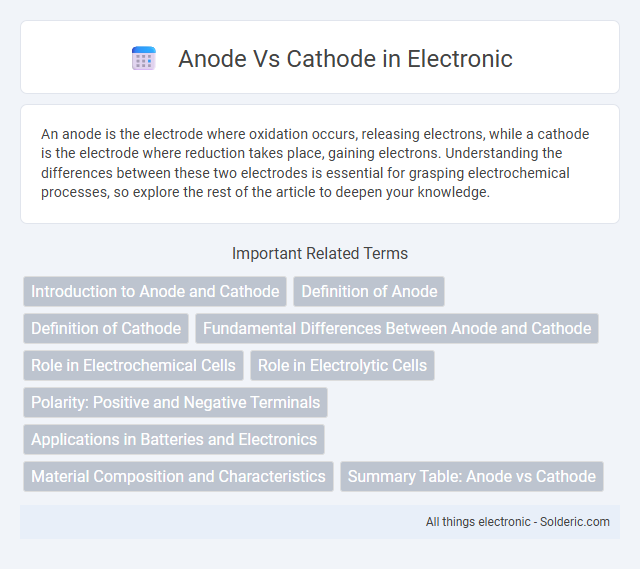An anode is the electrode where oxidation occurs, releasing electrons, while a cathode is the electrode where reduction takes place, gaining electrons. Understanding the differences between these two electrodes is essential for grasping electrochemical processes, so explore the rest of the article to deepen your knowledge.
Comparison Table
| Aspect | Anode | Cathode |
|---|---|---|
| Definition | Electrode where oxidation occurs | Electrode where reduction occurs |
| Charge in Electrolytic Cell | Positive | Negative |
| Charge in Galvanic Cell | Negative | Positive |
| Electron Flow | Electrons leave the anode | Electrons enter the cathode |
| Ion Movement | Cations move away from anode | Anions move toward cathode |
| Role in Batteries | Source of electrons; oxidation site | Electron acceptor; reduction site |
| Example | Zinc electrode in Zn-Cu cell | Copper electrode in Zn-Cu cell |
Introduction to Anode and Cathode
Anodes are the electrodes where oxidation occurs, releasing electrons during electrochemical reactions, while cathodes are the sites of reduction, absorbing electrons to complete the circuit. In batteries, the anode typically serves as the negative terminal during discharge, and the cathode as the positive terminal. Understanding the distinct roles of anode and cathode in your device is essential for optimizing its performance and efficiency.
Definition of Anode
An anode is the electrode where oxidation occurs, characterized by the loss of electrons in an electrochemical cell. In electrolytic cells, the anode is positively charged, attracting anions, while in galvanic cells, it serves as the negative electrode. Understanding the anode's role is crucial for applications in batteries, corrosion processes, and electroplating.
Definition of Cathode
The cathode is the electrode where reduction occurs, meaning it gains electrons during an electrochemical reaction. In devices such as batteries and electrolytic cells, the cathode attracts cations and facilitates the conversion of ions into neutral atoms or molecules. Understanding the cathode's role is crucial for optimizing your electronic devices and energy storage systems.
Fundamental Differences Between Anode and Cathode
The fundamental differences between anode and cathode lie in their roles during electrochemical reactions: the anode is the electrode where oxidation occurs, releasing electrons, while the cathode is the site of reduction, gaining electrons. In galvanic cells, the anode is negative and the cathode positive, whereas in electrolytic cells, these charges reverse. Understanding these distinctions is crucial for optimizing battery performance and designing efficient electrochemical systems.
Role in Electrochemical Cells
The anode serves as the electrode where oxidation occurs, releasing electrons into the external circuit, while the cathode is the site of reduction, accepting electrons during electrochemical reactions. In galvanic cells, the anode is negatively charged, and the cathode is positively charged, facilitating electron flow to generate electrical energy. Your understanding of these roles is crucial for optimizing battery design and improving electrochemical cell efficiency.
Role in Electrolytic Cells
In electrolytic cells, the anode serves as the electrode where oxidation occurs, attracting anions and facilitating electron loss. The cathode acts as the site of reduction, attracting cations and enabling electron gain. This polarity arrangement drives non-spontaneous chemical reactions by applying external electrical energy.
Polarity: Positive and Negative Terminals
The anode is the positive terminal in a galvanic cell, where oxidation occurs and electrons flow away from it. The cathode serves as the negative terminal, attracting electrons and enabling reduction reactions. Understanding the polarity of these terminals is essential for correctly connecting your electronic devices and ensuring proper current flow.
Applications in Batteries and Electronics
Anodes and cathodes play crucial roles in batteries and electronics, where the anode serves as the negative electrode releasing electrons and the cathode acts as the positive electrode accepting electrons during discharge. In lithium-ion batteries, graphite is commonly used as the anode for its efficient lithium-ion intercalation, while lithium cobalt oxide or lithium iron phosphate serves as the cathode, providing high energy density and stable cycling. Electronic devices rely on these electrodes for controlling electron flow in semiconductors, with cathodes often functioning as electron emitters in vacuum tubes and anodes collecting electrons in sensors and detectors.
Material Composition and Characteristics
Anodes are typically composed of materials like zinc, lithium, or graphite, chosen for their ability to release electrons during oxidation, while cathodes often use metal oxides such as lithium cobalt oxide or manganese dioxide to efficiently accept electrons during reduction. The material characteristics of anodes include high electron donation capacity and structural stability during discharge, whereas cathodes are optimized for electron acceptance and ionic conductivity. Understanding these differences in material composition and properties is crucial for enhancing battery performance and longevity in your energy storage applications.
Summary Table: Anode vs Cathode
Anode and cathode differ fundamentally in electron flow and chemical reactions; the anode is where oxidation occurs, releasing electrons, while the cathode is the site of reduction, gaining electrons. In electrolytic cells, the anode is positive and the cathode negative, but in galvanic cells, these polarities reverse. A summary table highlights these distinctions focusing on electron flow, reaction types, and polarity in different electrochemical cells.
Anode vs Cathode Infographic

 solderic.com
solderic.com